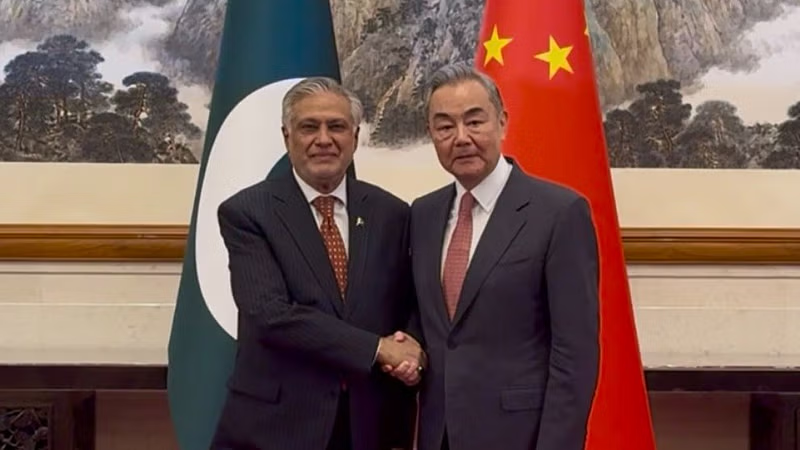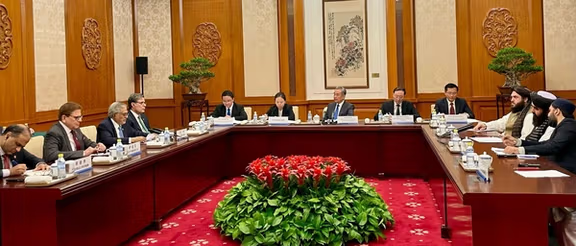
In a significant development poised to reshape the geopolitical and economic landscape of South and Central Asia, China and Pakistan have jointly agreed to expand the China-Pakistan Economic Corridor (CPEC) into Afghanistan. This strategic move marks a transformative milestone in regional connectivity and cooperation, raising hopes of enhanced peace and prosperity in an area long plagued by conflict and fragmentation. This agreement not only reflects China’s expanding influence through its Belt and Road Initiative (BRI) but also signals a renewed commitment to economic diplomacy as a means to foster stability and integration across some of the most challenging terrains in Asia.
Strengthening Regional Peace and Stability Through Economic Integration
The announcement to extend CPEC beyond Pakistan’s borders and into Afghanistan transcends the realm of conventional infrastructure development. It represents a deliberate strategy by China and Pakistan to weave Afghanistan into a regional economic fabric that could serve as a foundation for lasting peace. The region’s history of conflict, marked by decades of warfare and political instability, has left Afghanistan isolated, both economically and diplomatically. By connecting Afghanistan to the broader network of trade routes and development projects under CPEC, the hope is to create mutual economic dependencies that can discourage conflict and incentivize cooperation.
Afghanistan has long been a geopolitical hotspot, where competing regional and global interests have collided. For years, efforts to bring peace to Afghanistan have largely centered on political negotiations and military interventions, with limited success. This fresh approach of leveraging infrastructure and trade to generate stability is grounded in the belief that economic growth can address some root causes of unrest — unemployment, poverty, and lack of development. When communities see tangible benefits from cooperation, the incentives to maintain peace strengthen.
China’s vision of a “community of shared destiny” resonates strongly here. Under the Belt and Road Initiative, connectivity projects are designed not only to enhance trade but also to foster diplomatic ties and regional cohesion. The expansion of CPEC into Afghanistan aligns with this vision, offering a pathway for Afghanistan to integrate into regional supply chains, attract foreign investment, and diversify its economy beyond traditional aid dependencies.
CPEC: A Backbone of Regional Connectivity and Economic Development
Since its inception, the China-Pakistan Economic Corridor has emerged as one of the most ambitious and transformative infrastructure projects in Asia. Stretching over 3,000 kilometers, CPEC connects China’s western Xinjiang province to Pakistan’s strategic Gwadar port on the Arabian Sea. This corridor comprises a complex network of highways, railways, energy projects, and industrial zones designed to facilitate trade and development.
For Pakistan, CPEC has already brought substantial benefits, including enhanced energy production to tackle chronic shortages, improved road networks that boost internal trade, and new economic zones that stimulate manufacturing and employment. Pakistan’s integration into this corridor has increased its regional economic relevance and created a vital link in China’s broader Belt and Road Initiative.
The proposed extension into Afghanistan is expected to mirror these benefits, albeit on a challenging terrain. Afghanistan’s economy, rich in untapped mineral resources and agricultural potential, has remained underdeveloped due to conflict and poor infrastructure. By extending CPEC’s reach, Afghanistan could finally access modern transport routes that open new avenues for exports and imports. This connectivity is crucial for landlocked Afghanistan, which faces significant logistical challenges in accessing global markets.
Furthermore, the expansion could enhance energy cooperation, connecting Afghanistan to Pakistan’s electricity grid and potentially to China’s energy projects. Afghanistan’s persistent energy shortages have been a major barrier to industrial growth and everyday life improvements. Reliable energy access could spur the development of industries and services, improve healthcare and education facilities, and uplift millions of lives.
Diplomatic Implications and Regional Reactions
The strategic decision to expand CPEC to Afghanistan carries substantial diplomatic implications, illustrating China’s evolving regional policy and Pakistan’s role as a regional connector. Beijing’s involvement in Afghanistan, via economic corridors rather than direct military engagement, reflects a cautious but growing presence in the country’s future.
China’s motivations are multifaceted. Firstly, stabilizing Afghanistan through economic development reduces risks of extremism and militancy spilling over into its sensitive Xinjiang region. Secondly, securing trade routes and expanding influence through infrastructure strengthens China’s geopolitical footprint in South and Central Asia. Pakistan, for its part, views this expansion as an opportunity to deepen bilateral ties with Afghanistan, facilitate cross-border trade, and promote peace along its western frontier — all of which serve Islamabad’s strategic interests.
The reactions of neighboring countries and regional powers vary. Iran, sharing borders with both Afghanistan and Pakistan, stands to benefit from increased trade and connectivity. Central Asian republics, eager to expand their trade routes to the Arabian Sea, may also welcome this initiative. However, India’s response is expected to be cautious. India has historically opposed CPEC due to the corridor passing through Pakistan-administered Kashmir and views the extension to Afghanistan through the prism of its own regional security concerns.
Despite these geopolitical complexities, the consensus among many analysts is that greater regional integration is a positive step. Increased economic cooperation often creates channels for dialogue and reduces the likelihood of conflict, fostering a more stable environment conducive to growth.
Challenges Ahead: Security, Political Stability, and Infrastructure
While the prospects of CPEC expansion are promising, the path is fraught with significant challenges. Afghanistan’s security situation remains precarious. Although the international military presence has reduced, insurgency, factional violence, and political instability continue to jeopardize development projects.
Ensuring the safety of infrastructure investments and personnel will require coordinated security arrangements between China, Pakistan, and Afghanistan. Historical precedents show that infrastructure projects in conflict zones can be prime targets for attacks, disrupting progress and raising costs.
Political instability is another major concern. Afghanistan’s governance remains fragile, with power struggles and limited central authority complicating the execution of large-scale projects. For CPEC expansion to be successful, Afghanistan will need sustained political will, transparent administration, and effective coordination with China and Pakistan.
Infrastructure development within Afghanistan itself will require substantial financing and expertise. Years of conflict have left transport networks and energy grids in ruins. Building roads, railways, and power plants will necessitate not only technical capacity but also addressing local social dynamics, land rights, and environmental concerns.
Economic Prospects: Unlocking Afghanistan’s Potential
Despite these challenges, the economic potential unlocked by integrating Afghanistan into the CPEC framework is immense. Afghanistan is endowed with vast mineral resources — including lithium, copper, iron ore, and rare earth elements — that are critical for the global supply chains of high-tech industries. However, political instability and lack of infrastructure have long kept these resources underexploited.
By connecting Afghanistan to international markets through Gwadar port and China’s network, mining operations could scale up, attracting foreign direct investment and fostering technological transfer. This would not only boost government revenues but also create thousands of jobs in mining, processing, and logistics.
Agriculture, the mainstay for the majority of Afghanistan’s population, stands to benefit as well. Improved transport infrastructure will enable farmers to reach markets efficiently, reducing post-harvest losses and increasing incomes. Cross-border trade of agricultural products with Pakistan, China, and beyond could expand, diversifying local economies.
Energy cooperation is expected to play a transformative role. Afghanistan’s chronic energy shortages restrict industrialization and basic services. With CPEC integration, Afghanistan could gain access to Pakistan’s power grid and possibly Chinese renewable energy projects, enhancing energy security and sustainability.
Beyond these sectors, new industrial zones and special economic areas modeled after Pakistan’s successful CPEC zones could emerge in Afghanistan, promoting manufacturing and export-oriented industries. Such developments could serve as engines of economic growth and social stability.
A Broader Vision for Regional Integration

The extension of CPEC into Afghanistan is emblematic of a wider vision to integrate South and Central Asia into a cohesive economic region. China’s Belt and Road Initiative aims to create a network of connectivity that links markets, people, and cultures, fostering shared development and cooperation.
This initiative has the potential to transform a historically fragmented and conflict-prone region into a corridor of economic dynamism and cooperation. For Afghanistan, long isolated from the world due to security concerns and geographic constraints, participation in this corridor symbolizes hope for a new future defined by opportunity and partnership.
The success of this vision depends on collaboration among multiple stakeholders — governments, local communities, businesses, and international partners. It requires harmonizing policies, addressing security concerns, and investing in sustainable infrastructure that benefits all participants.
If implemented effectively, the expanded CPEC could become a model for how economic integration can underpin peacebuilding and regional development in post-conflict settings.
Historical Context and Strategic Significance of CPEC Expansion
To fully grasp the importance of expanding CPEC into Afghanistan, it is essential to understand the historical and strategic background of the China-Pakistan Economic Corridor and the geopolitical dynamics in the region.
Since the early 2010s, CPEC has symbolized a deepening partnership between China and Pakistan. It is not just an economic project but a strategic lifeline for China, providing access to the Arabian Sea via Gwadar port and a route that bypasses the vulnerable maritime chokepoints such as the Malacca Strait. For Pakistan, CPEC represents an economic revival plan, promising infrastructure modernization and increased foreign investment.
Extending this corridor into Afghanistan carries strategic significance on multiple levels. Firstly, it allows China to deepen its presence in Central Asia, linking it more directly to South Asia’s markets and resources. Secondly, it provides Pakistan with a mechanism to enhance trade and transit ties with Afghanistan, helping to stabilize a volatile border region.
Moreover, the inclusion of Afghanistan into CPEC signals a potential new chapter in Afghanistan’s regional engagement after years of isolation and conflict. It opens avenues for Afghanistan to benefit from one of Asia’s largest infrastructure projects and participate more fully in regional economic dynamics.
Impact on Afghanistan’s Socioeconomic Fabric
Beyond the economic statistics and infrastructure plans, the expansion of CPEC could have profound effects on Afghanistan’s social fabric. Economic development and job creation could help address some of the root causes of conflict — poverty, unemployment, and lack of opportunity — which often fuel insurgency and unrest.
Improved infrastructure can increase access to education, healthcare, and markets for rural communities, fostering inclusiveness and social cohesion. Women, youth, and marginalized groups stand to benefit from new employment and entrepreneurial opportunities emerging from construction, manufacturing, and service sectors linked to the corridor.
Furthermore, cross-border trade and cultural exchanges enabled by improved connectivity may promote greater regional understanding and integration, reducing ethnic and sectarian tensions that have historically undermined Afghan stability.
Environmental and Sustainability Considerations
No infrastructure project of this scale can overlook environmental and sustainability concerns. The expansion of CPEC into Afghanistan must be planned and executed with attention to minimizing environmental damage, preserving natural habitats, and ensuring sustainable resource use.
Afghanistan’s rugged terrain and fragile ecosystems require careful environmental impact assessments. Energy projects incorporated into the corridor could increasingly focus on renewable sources such as solar and wind, aligning with global trends toward green infrastructure.
Sustainability also means involving local communities in planning processes, ensuring that economic benefits are equitably distributed, and that social and cultural values are respected.
The Road Ahead: Prospects and Partnerships
Looking forward, the successful expansion of CPEC into Afghanistan depends on forging strong partnerships, mobilizing financial resources, and maintaining political will across all stakeholders. International cooperation, including from multilateral development banks and regional organizations, could play a vital role in supporting the initiative.
China and Pakistan’s commitment to this project sends a powerful message about the potential of infrastructure-led development to overcome complex challenges. However, the realization of this vision will require persistent effort, adaptability, and inclusive engagement.
As Afghanistan moves toward greater connectivity and economic integration, the region as a whole stands at the cusp of a potential transformation — one where peace and prosperity are achievable through shared investment in a connected future.

